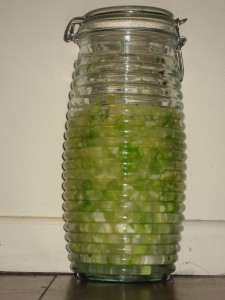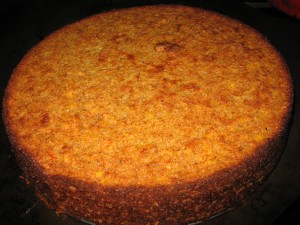Sauerkraut is the easiest thing in the world to make, last forever, is much healthier for you than the ingredients it’s made from, and is super-good when served on the side with sausages and mashed potatoes! All you need is a big glass mason jar with a rubber seal lid, a potato masher, a big plastic bowl, a knife and board, one organic cabbage, and a tablespoon of salt.
Firstly, boil your mason jar to sterilize it, then set aside.
Remove any outer leaves that you don’t like the look of and rinse the cabbage. Cut it in half lengthwise, then slice along its perimeter into half-moon strips that are roughly 1/4″ to 1/2″ wide.
Put a quarter of the shredded cabbage into your bowl, add all of the salt, and pound hard with the potato masher. The idea is to bruise the leaves to hard that they wilt and release their juice. After about 5 minutes, empty the contents of the bowl into the clean mason jar.
Refill the bowl with more cabbage and repeat the same process of pounding it.
Repeat this step until all of the cabbage has been processed and is in the jar.
Press the cabbage down in the jar so that the juices are at least an inch above the cabbage. Seal the jar with its lid, and put in a cool dark cupboard for a week. Every few days, remove the jar and open the sealed lid to allow fermented gases to escape, then re-seal and put it back in the cupboard.
After about a week, transfer the sauerkraut to you fridge, when it will keep indefinitely.
Eat cold, or gently heat so you don’t destroy the beneficial cultures that are in there, which are just like the good stuff in yogurt.





